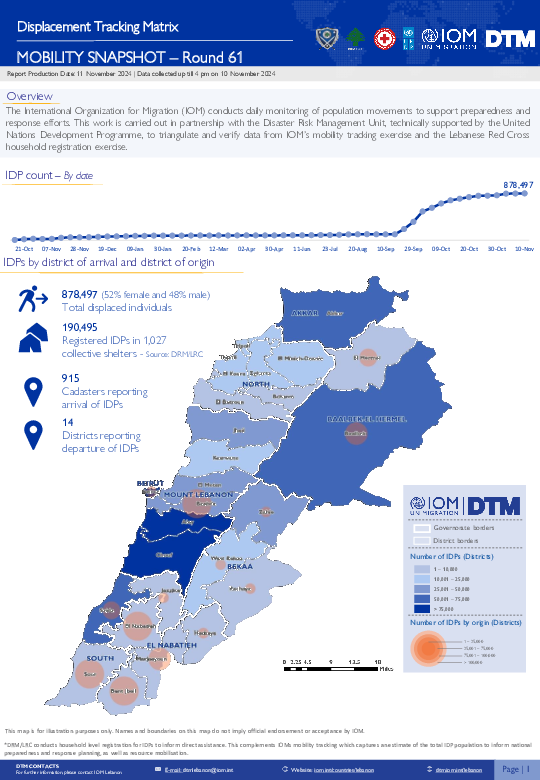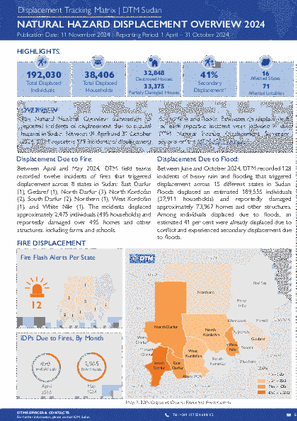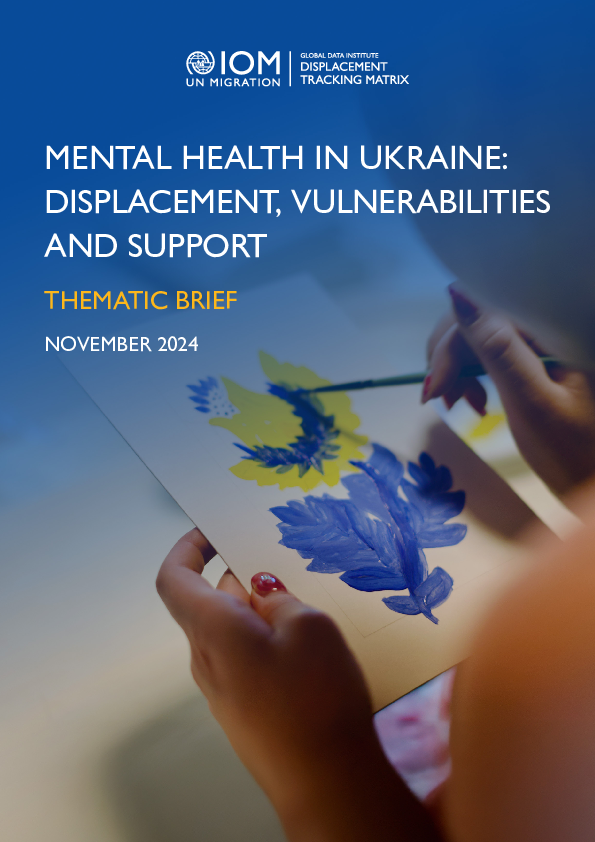-
Countries
-
Data and Analysis
-
Special Focus
-
Crisis Responses
Internal displacement
Domain host
displacement.iom.int
Contact
DTMUkraine@iom.int
Location
Ukraine
Activity
- Mobility Tracking
- Baseline Assessment
Period Covered
Jul 01 2024 -Aug 31 2024
- Kharkivska (388,410), Dnipropetrovska (377,713), and Kyivska (256,397) Oblasts have the highest numbers of officially registered IDPs.
- Across the country, around 5 per cent of registered IDPs have a state-recognised disability status.
- Sixty per cent of registered IDPs were female, whereas 40 per cent were male. Twenty–nine per cent of registered IDPs were under 18, 48 per cent – between 18 and 59, and 23 per cent were aged 60 and over.
A more detailed version of this dataset at the Hromada level is available. To get access, kindly click on the 'Request Access' button.
Population Groups
IDPs
Survey Methodology
Unit of Analysis Or Observation
Admin Area 2
Admin Area 3
Type of Survey or Assessment
Key Informant
Keywords
Geographical Scope Partial Coverage
Administrative boundaries with available data
The current dataset covers the following administrative boundaries
Contact
DTMUkraine@iom.int
Location
Ukraine
Activity
- Mobility Tracking
- Baseline Assessment
Period Covered
Sep 01 2024 -Oct 31 2024
- Kharkivska (390,872), Dnipropetrovska (379,133), and Kyivska (257,606) Oblasts have the highest numbers of officially registered IDPs.
- Across the country, around 10 per cent of registered IDPs have a state-recognised disability status.
- Sixty per cent of registered IDPs were female, whereas 40 per cent were male. Twenty–five per cent of registered IDPs were under 18, 52 per cent – between 18 and 59, and 23 per cent were aged 60 and over.
A more detailed version of this dataset at the Hromada level is available. To get access, kindly click on the 'Request Access' button.
Population Groups
IDPs
Survey Methodology
Unit of Analysis Or Observation
Admin Area 2
Admin Area 3
Type of Survey or Assessment
Key Informant
Keywords
Geographical Scope Partial Coverage
Administrative boundaries with available data
The current dataset covers the following administrative boundaries

Contact
dtmlebanon@iom.int
Language
English
Location
Lebanon
Period Covered
Oct 10 2023
Nov 10 2024
Activity
- Mobility Tracking
- Baseline Assessment
Since October 8 there has been an increase in cross-border incidents between Israel and Lebanon, resulting in the displacement of people both within the South and elsewhere within the country. Since October 10, the Displacement Tracking Matrix (DTM) has been conducting the daily monitoring of population movements. The objective of the exercise is to inform preparedness and response planning.
Contact
dtmlebanon@iom.int
Location
Lebanon
Activity
- Mobility Tracking
- Baseline Assessment
Period Covered
Oct 10 2023 -Nov 06 2024
Since October 8 there has been an increase in cross-border incidents between Israel and Lebanon, resulting in the displacement of people both within the South and elsewhere within the country. Since October 10, the Displacement Tracking Matrix (DTM) has been conducting the daily monitoring of population movements. The objective of the exercise is to inform preparedness and response planning.
To get access kindly click on the 'Request Access' button. Please use your official work email, and specify the organisation name. Thank you.
Population Groups
IDPs
Survey Methodology
Unit of Analysis Or Observation
Admin Area 2
Admin Area 3
Household
Individual
Type of Survey or Assessment
Key Informant
Keywords
Geographical Scope Full Coverage
Administrative boundaries with available data
The current dataset covers the following administrative boundaries

Contact
DTM Sudan; dtmsudan@iom.int
Language
English
Location
Sudan
Period Covered
Apr 01 2024
Oct 31 2024
Activity
- Mobility Tracking
- Event Tracking
The Natural Hazard Overview provides a summary of reported incidents of displacement in Sudan due to natural hazards, including fires and floods. DTM Sudan reported on increased displacement due to fires between April and July 2024, and increased displacement due to floods between July and October 2024.
Between 01 April and 31 October 2024, DTM Sudan reported 140 incidents of sudden displacement due to natural hazard incidents. Information on earlier reported incidents of fire and flood induced displacement is available in the weekly Natural Hazard Displacement Summary reports, available on the DTM Sudan website.
Highlights
- DTM reported on 12 incidents of displacement due to fires and 128 incidents of displacement due to heavy rain or floods in 16 different states across Sudan.
- The reported incidents displaced an estimated 192,030 individuals (38,406 households).
Note: DTM reports on incidents of sudden displacement due to natural hazards via Early Warning Flash Alerts, published within 24 to 48 hours of reported incidents and distributed via the DTM Sudan mailing list. Figures should be understood as preliminary estimates on displacement due to a specific reported event, and therefore may or may not reflect broader displacement dynamics in Sudan.
For further information, see DTM Sudan Methodological Note. For more granular information on displacement and mobility across Sudan, see DTM Sudan Mobility Update (10).

Contact
DTM Ukraine, dtmukraine@iom.int
Language
English
Location
Ukraine
Period Covered
Jul 13 2024
Aug 12 2024
Activity
- Survey
As of October 2024, an estimated 3.6 million people remain internally displaced in Ukraine, while 4.3 million previously displaced people have returned to their primary place of residence (IOM GPS R18). The war continues to have a significant impact on the country’s economy and on people’s livelihoods and living standards.
The protracted nature of the conflict and the uncertainty about the future it creates, together with unfavorable economic conditions, are expected to have a significant and lasting impact on the mental health of the Ukrainian population. Against this backdrop, this brief provides an overview of the population groups most at risk of experiencing symptoms of depression, examining factors such as gender, age, and disability. It also explores the relationship between mental health and displacement status, as well as individual and household-level socioeconomic characteristics, and outlines support needs. Finally, the brief presents recommendations for mental health and psychosocial support (MHPSS) programming across Ukraine, aiming to inform targeted assistance to address the pressing mental health challenges facing vulnerable populations affected by conflict
Contact
DTM Yemen, iomyemendtm@iom.int
Location
Yemen
Activity
- Mobility Tracking
- Event Tracking
Period Covered
Nov 03 2024 -Nov 09 2024
From 1 January to 9 November 2024, IOM Yemen DTM tracked 3,112 households (HH) (18,672 Individuals) who experienced displacement at least once.
Between 3 and 9 November 2024, IOM Yemen DTM tracked 30 households (180 individuals) displaced at least once. The majority of people moved into/within the following governorates and districts:
- Ma’rib (21 HH) – Ma’rib City (10 HHs), Ma’rib (9 HHs), Harib (2 HHs) districts. Most displacements in the governorate originated from Al Jawf and Ibb.
- Al Hodeidah (5 HHs) – Al Khukhah (4 HHs), Hays (1 HH) districts. All displacements in the governorate were internal.
- Ta’iz (4 HHs) – Jabal Habashi (4 HHs) district. All displacements in the governorate were internal.
The majority of people moved from the following governorates and districts:
- Al Hodeidah (8 HHs) – At Tuhayta (3 HHs), Jabal Ras (2 HHs), Al Marawiah (1 HH) districts.
- Ta’iz (7 HHs) – Maqbanah (4 HHs), Ash Shamayatayn (1 HH), Al Makha (1 HH) districts.
- Ibb (5 HHs) – An Nadirah (2 HHs), Hobeish (1 HH), Hazm Al Odayn (1 HH) districts.
Population Groups
IDPs
Returnee (Previously Internally Displaced)
Survey Methodology
Unit of Analysis Or Observation
Admin Area 2
Type of Survey or Assessment
Household
Key Informant
Keywords
Geographical Scope Partial Coverage
Administrative boundaries with available data
The current dataset covers the following administrative boundaries

Contact
DTM Yemen, iomyemendtm@iom.int
Language
English
Location
Yemen
Period Covered
Nov 03 2024
Nov 09 2024
Activity
- Mobility Tracking
- Event Tracking
IOM Yemen DTM’s Rapid Displacement Tracking (RDT) tool collects data on estimated numbers of households forced to flee on a daily basis from their locations of origin or displacement, allowing for regular reporting of new displacements in terms of estimated numbers, geography, and needs. It also tracks returnees who returned to their location of origin.
From 1 January to 9 November 2024, IOM Yemen DTM tracked 3,112 households (HH) (18,672 Individuals) who experienced displacement at least once.
Between 3 and 9 November 2024, IOM Yemen DTM tracked 30 households (180 individuals) displaced at least once. The majority of people moved into/within the following governorates and districts:
- Ma’rib (21 HH) – Ma’rib City (10 HHs), Ma’rib (9 HHs), Harib (2 HHs) districts. Most displacements in the governorate originated from Al Jawf and Ibb.
- Al Hodeidah (5 HHs) – Al Khukhah (4 HHs), Hays (1 HH) districts. All displacements in the governorate were internal.
- Ta’iz (4 HHs) – Jabal Habashi (4 HHs) district. All displacements in the governorate were internal.
The majority of people moved from the following governorates and districts:
- Al Hodeidah (8 HHs) – At Tuhayta (3 HHs), Jabal Ras (2 HHs), Al Marawiah (1 HH) districts.
- Ta’iz (7 HHs) – Maqbanah (4 HHs), Ash Shamayatayn (1 HH), Al Makha (1 HH) districts.
- Ibb (5 HHs) – An Nadirah (2 HHs), Hobeish (1 HH), Hazm Al Odayn (1 HH) districts.
IOM identified 22 additional households displaced in the previous reporting period, which covered 27 October - 02 November 2024, in the governorates of Ta’iz (12 HHs), Ma’rib (8 HHs), and Al Hodeidah (2 HHs). These figures have been added to the cumulative displacement total recorded since the beginning of the year.
- 23 October and 08 of November 2024, attacks in Mueda, Muidumbe, Mocimboa da Praia and Nangade displaced 4,095 individuals; urgent needs include food and shelter as detailed in Movement Alert #116.
- Displacement trends between 23 October and 08 of November 2024, show a spike at 1,070 individuals on 28 October and 1,114 on the 7 November, indicating intensified movement due to increased attacks and fear of violence.
- Current movement patterns show Nangade (Litingina) to Nangade Sede and M’Tamba within Nangade district as the largest displacement flow with 2,053 individuals, followed by Chapa (Oumba) to Chapa (Nanhala) with 1,667 individuals alongside smaller movements from Diaca, Mapate, and Mbau to nearby safer areas, highlighting the spread of displacement within local communities.

Contact
DTM Nigeria, iomnigeriadtm@iom.int
Language
English
Location
Nigeria
Period Covered
Oct 28 2024
Nov 03 2024
Activity
- Mobility Tracking
- Event Tracking
Between 28 October and 3 November 2024, a total of 826 new arrivals were recorded at locations in Adamawa and Borno states.
TT assessments identified the following movement triggers: farmer-herders clash (190 individuals or 23%), fear of attack (168 individuals or 20%), poor living conditions (165 individuals or 20%), government re-integration (83 individuals or 10%), access to humanitarian support (72 individuals or 9%), seasonal farming (68 individuals or 8%), attacks (50 individuals or 6%) and flood (30 individuals or 4%).
Pagination
- Previous page
- Page 6
- Next page

